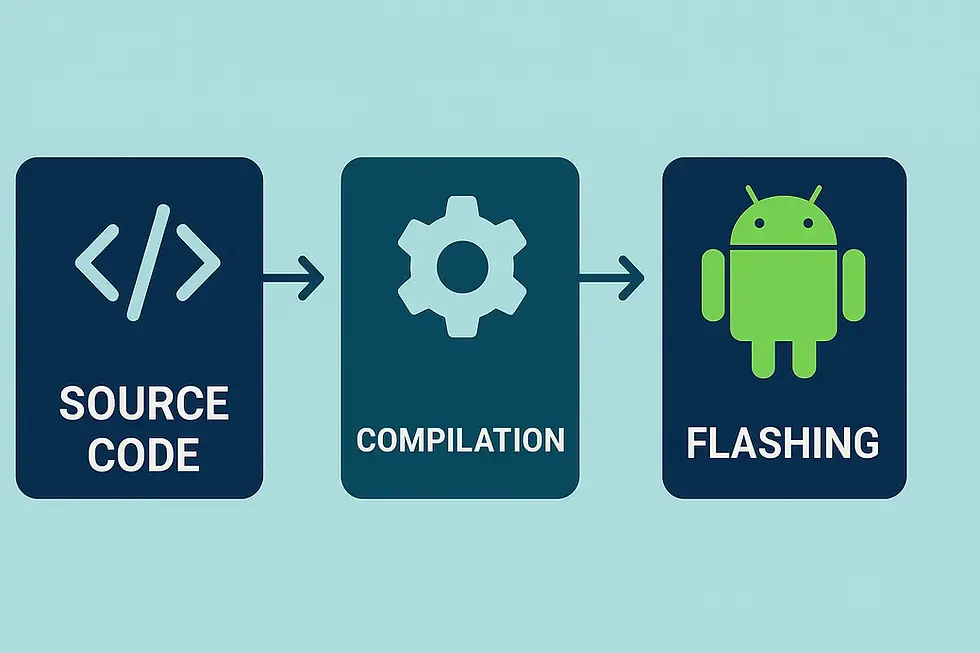Introduction to Android Kernel Development for Beginners
- Kalyan Bhattacharjee

- Jul 2
- 3 min read
Updated: Nov 19

Unlocking the Core of Android Customization | Android Kernel Development
What Is the Android Kernel? 🧠
The Android kernel is the bridge between the hardware and the software in your smartphone. Think of it as the brainstem of your device it controls essential functions like memory, CPU scheduling, battery usage, device drivers, and system calls.
Under the hood, Android runs on a modified version of the Linux kernel, customized to suit mobile hardware, touch inputs, power management, and more.
Why Should You Learn Android Kernel Development? 🤖
Learning Android kernel development opens the door to:
🔧 Custom ROM development
⚡ Performance tuning & battery optimizations
🔄 Fixing bugs at a deeper level
🛠️ Developing unique kernel features (like double-tap to wake, CPU undervolting, etc.)
It’s a key skill for advanced Android developers, XDA contributors, and tech-savvy modders who want complete control over how Android works.
Key Components of the Android Kernel 🧰
Here are the core components you’ll work with as a kernel developer:
Component | Description |
Kernel Image (zImage/Image.gz) | The compiled version of the kernel used during boot. |
Device Tree (DTB) | Hardware-specific data (CPU, memory, camera, etc.). |
Ramdisk | Contains essential files for mounting the system. |
Init | The first user-space process, starts Android services. |
Drivers | Kernel modules for Wi-Fi, Bluetooth, GPU, etc. |
Prerequisites: What You Need to Get Started 🛠️
Before diving into kernel development, make sure you have:
💻 Linux-based OS (Ubuntu or Debian recommended)
🧵 Basic knowledge of C and Bash
📦 AOSP or device source code
🛠️ GCC or Clang cross-compiler toolchain
📱 A rooted Android device with an unlocked bootloader
🔄 TWRP (or other custom recovery) for flashing custom kernels
💡 Tip: Always use a test device not your daily driver when compiling and flashing kernels.
The Kernel Development Workflow (Simplified) 🧪
The Android kernel development process may sound complex, but breaking it into clear steps makes it easier to understand. Here’s a simplified view of how developers build, modify, and optimize the Android kernel.
Get Device Tree & Kernel Source Code
Download from OEMs like Xiaomi, OnePlus, Samsung, or AOSP GitHub mirrors.
Clone with Git:git clone https://github.com/<device-kernel>.git
Setup Toolchain & Environment
Install required packages:sudo apt install gcc make bc bison flex libssl-dev
Configure the Kernel
Load default config:make <device_defconfig>
Compile the Kernel
Run:make -j$(nproc)
Pack the Image with AnyKernel3 (or similar)
Used for flashing via recovery.
Copy the Image.gz-dtb into the AnyKernel3 zip folder.
Flash on Device
Boot to TWRP → Flash ZIP → Reboot.
Always keep a backup!
Common Challenges & Mistakes ⚠️
❌ Using wrong defconfig (won’t boot)
❌ Misconfigured DTB or ramdisk (bootloop)
❌ Incompatible toolchain (compiler mismatch)
❌ Failing to backup original kernel before testing
🔧 Debugging a kernel is a mix of patience and log reading use dmesg and logcat extensively.
Going Further: Advanced Kernel Features 🚀
Once you're comfortable with the basics, explore:
✅ CPU governor tweaks
✅ Battery-saving tweaks (e.g., wakelocks)
✅ F2FS support over EXT4
✅ Overclocking/undervolting
✅ Custom kernel modules (e.g., WireGuard, ZRAM)
✅ Real-time scheduling and low-latency kernels
You can also contribute to open-source kernel projects or start your own custom kernel builds like Kirisakura, ElementalX, or Franco Kernel.
Learning Resources for Beginners 📚
Start your kernel journey with these beginner-friendly platforms, guides, and communities curated for aspiring Android developers.
GitHub Repos: Search for "AnyKernel3", "Kirisakura", or "CAF kernels"
YouTube Channels like ExplainingComputers, Techies Explains, or MakeUseOf Tech
Testing and Iteration: The Key to Mastery 🔄
Kernel development is not a one-and-done process it’s all about testing, debugging, and improving. Once you flash your custom kernel, pay close attention to logs (dmesg, logcat), monitor thermals and battery drain, and gather feedback from real-world usage. Don’t be afraid of bootloops or bugs these are part of the learning curve.
With each iteration, you’ll gain a deeper understanding of how the kernel interacts with hardware, giving you the power to optimize and innovate at the core level of Android.

Key Takeaways ✅
Learning Android kernel development isn’t for the faint-hearted, but it’s one of the most powerful and rewarding skills for Android enthusiasts. Whether you're optimizing your device for performance or contributing to the custom ROM community, understanding the kernel puts you in full control of Android’s beating heart.
📝 Written by Kalyan Bhattacharjee
Tech Blogger | Android Customization Enthusiast | Fintech Shield
Related Keywords: android kernel development 2025, android custom kernel, how to compile android kernel, kernel development for android, build android kernel from source, android device tree and defconfig, anyKernel3 guide, rooted android kernel tweaks, aosp kernel compilation, linux kernel for android devices, custom rom kernel building, android kernel development, android kernel, android kernel for beginners, fintech shield







Comments